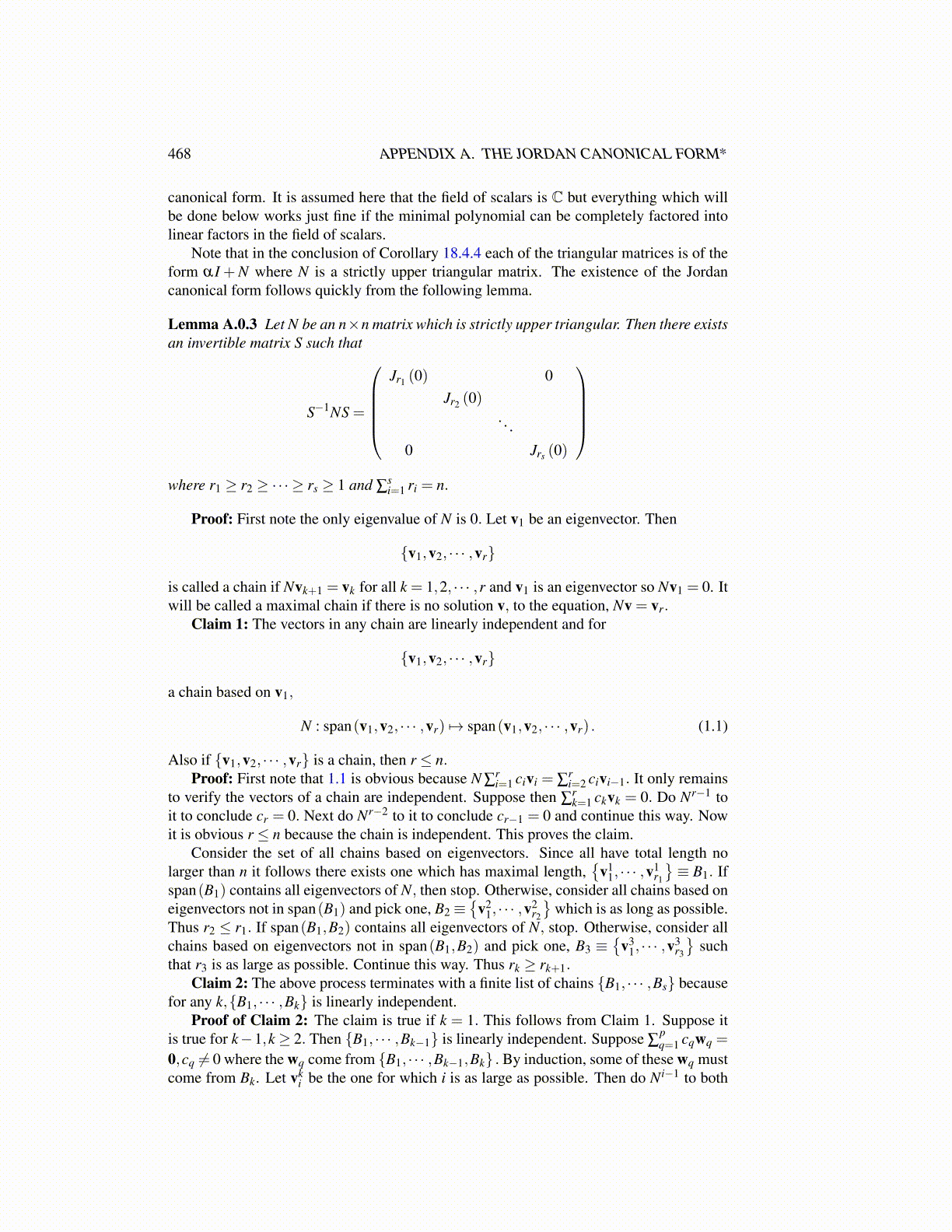
468 APPENDIX A. THE JORDAN CANONICAL FORM*
canonical form. It is assumed here that the field of scalars is C but everything which willbe done below works just fine if the minimal polynomial can be completely factored intolinear factors in the field of scalars.
Note that in the conclusion of Corollary 18.4.4 each of the triangular matrices is of theform αI +N where N is a strictly upper triangular matrix. The existence of the Jordancanonical form follows quickly from the following lemma.
Lemma A.0.3 Let N be an n×n matrix which is strictly upper triangular. Then there existsan invertible matrix S such that
S−1NS =
Jr1 (0) 0
Jr2 (0). . .
0 Jrs (0)
where r1 ≥ r2 ≥ ·· · ≥ rs ≥ 1 and ∑
si=1 ri = n.
Proof: First note the only eigenvalue of N is 0. Let v1 be an eigenvector. Then
{v1,v2, · · · ,vr}
is called a chain if Nvk+1 = vk for all k = 1,2, · · · ,r and v1 is an eigenvector so Nv1 = 0. Itwill be called a maximal chain if there is no solution v, to the equation, Nv = vr.
Claim 1: The vectors in any chain are linearly independent and for
{v1,v2, · · · ,vr}
a chain based on v1,
N : span(v1,v2, · · · ,vr) 7→ span(v1,v2, · · · ,vr) . (1.1)
Also if {v1,v2, · · · ,vr} is a chain, then r ≤ n.Proof: First note that 1.1 is obvious because N ∑
ri=1 civi = ∑
ri=2 civi−1. It only remains
to verify the vectors of a chain are independent. Suppose then ∑rk=1 ckvk = 0. Do Nr−1 to
it to conclude cr = 0. Next do Nr−2 to it to conclude cr−1 = 0 and continue this way. Nowit is obvious r ≤ n because the chain is independent. This proves the claim.
Consider the set of all chains based on eigenvectors. Since all have total length nolarger than n it follows there exists one which has maximal length,
{v1
1, · · · ,v1r1
}≡ B1. If
span(B1) contains all eigenvectors of N, then stop. Otherwise, consider all chains based oneigenvectors not in span(B1) and pick one, B2 ≡
{v2
1, · · · ,v2r2
}which is as long as possible.
Thus r2 ≤ r1. If span(B1,B2) contains all eigenvectors of N, stop. Otherwise, consider allchains based on eigenvectors not in span(B1,B2) and pick one, B3 ≡
{v3
1, · · · ,v3r3
}such
that r3 is as large as possible. Continue this way. Thus rk ≥ rk+1.Claim 2: The above process terminates with a finite list of chains {B1, · · · ,Bs} because
for any k,{B1, · · · ,Bk} is linearly independent.Proof of Claim 2: The claim is true if k = 1. This follows from Claim 1. Suppose it
is true for k−1,k≥ 2. Then {B1, · · · ,Bk−1} is linearly independent. Suppose ∑pq=1 cqwq =
0,cq ̸= 0 where the wq come from {B1, · · · ,Bk−1,Bk} . By induction, some of these wq mustcome from Bk. Let vk
i be the one for which i is as large as possible. Then do Ni−1 to both